
Intro
When considering a new running shoe, there are so many similar-looking shoes on the market being made by so many different companies, it is virtually impossible to (1) know where to begin; (2) quickly figure out which one or two products from a given brand might work well for you; and (3) determine what products from other brands might be the most similar and also worth considering.
So in our new “Blister Brand Guide” series, we provide an overview of the entire product lineup of a brand; highlight how each product stands out from the rest of that brand’s lineup; and help you figure out quickly and easily which shoe might work best for you.
In our individual product reviews, we go very deep into the details of particular products. With these Brand Guides, the goal is not Depth, but Breadth. Our Brand Guides and full reviews are designed to complement each other — provide a broad overview of entire company lineups, and then also very detailed reviews of individual products.
Salomon: Brand Background
Since its beginning in the High Alps in 1947, Salomon has become one of the largest running shoe brands, particularly in the trail market.
Salomon’s shoes tend to run on the narrower end of the spectrum and offer more minimal cushioning, though they’ve diversified their line in recent years.
Salomon’s “high cushion” shoes are still much more minimal compared to the “high cushion” shoes from brands like Hoka and Altra. Salomon’s shoes generally provide a firmer ride and plenty of ground feel. While many individuals with wider feet struggle to find Salomon shoes that feel roomy enough in the midfoot, Salomon does have a few models that come in a “wide” version. Their shoes tend to have a higher heel-to-toe drop (typically in the 6-10 mm range) compared to many of their competitors’ shoes, so if you prefer a lower-drop shoe and / or tend to strike with your forefoot, this is important to keep in mind.
Salomon’s “S/Lab” shoes are designed for racing. They are the lightest shoes Salomon makes and tend to wear far faster than their other models. The S/Lab models also tend to have a lower drop than many of the other shoes Salomon makes. The S/Lab models often mirror another shoe in Salomon’s lineup, which we’ll mention in the brief summary of each shoe.
Most of Salomon’s trail shoes have a “quick lacing” system, designed with a “buckle” that slides down the laces to your desired tightness, rather than having to tie traditional laces. The buckle and excess lace then tuck into a pocket on the top of the tongue in each quick-lace shoe. All of Salomon’s current road shoes use a regular lacing system, while the vast majority of their trail shoes use quick laces.
Salomon also makes waterproof versions of many of their popular models, whether that’s with a Gore-Tex insert or Salomon’s proprietary ClimaSalomon waterproof insert. The waterproof versions will feel extremely similar to the non-waterproof versions in terms of support, cushioning, and midsole feel, but obviously provide better weather protection and they also tend to be significantly less breathable. Lastly, they also make several of their shoes in “Nocturne” versions, which feature a reflective print covering the entire upper of each shoe.
ROAD SHOES
(Most Cushioned to Least Cushioned)
Most Cushion
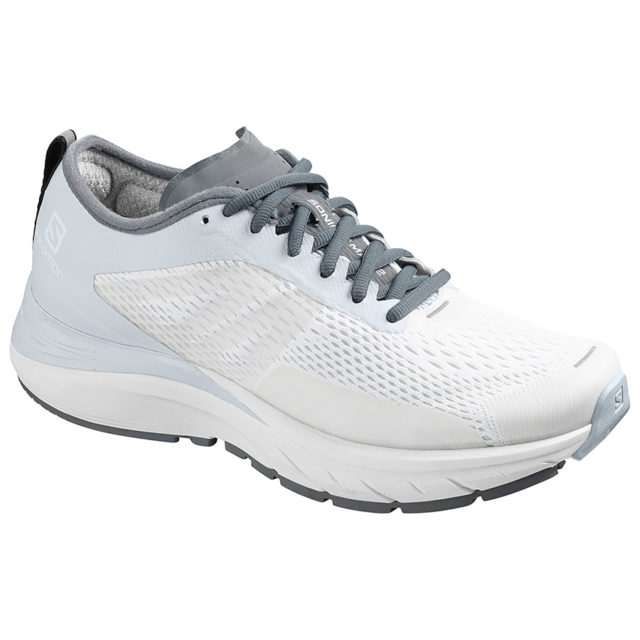
The RA Max 2 is Salomon’s most cushioned road shoe, and offers a slightly more structured, stable upper than many of Salomon’s road shoes. This shoe offers the plushest ride of any Salomon shoe, though compared to maximal shoes from brands like Hoka and Altra, the RA Max 2’s level of cushioning is not as high. But if you want a Salomon shoe that is well suited to long training runs on pavement, this shoe is worth a look.
Stack Height
- Heel: 30 mm
- Toe: 20 mm
Drop: 10 mm
Stated Weight
- Men's: 280 g
- Women's: 240 g
MSRP: $130.00
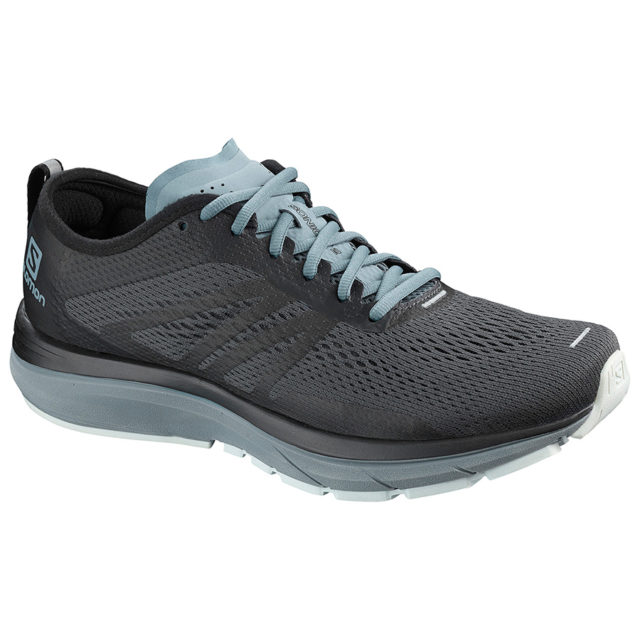
Stack Height
- Heel: 28 mm
- Toe: 20 mm
Drop: 8 mm
Stated Weight
- Men's: 260 g
- Women's: 220 g
MSRP: $130.00
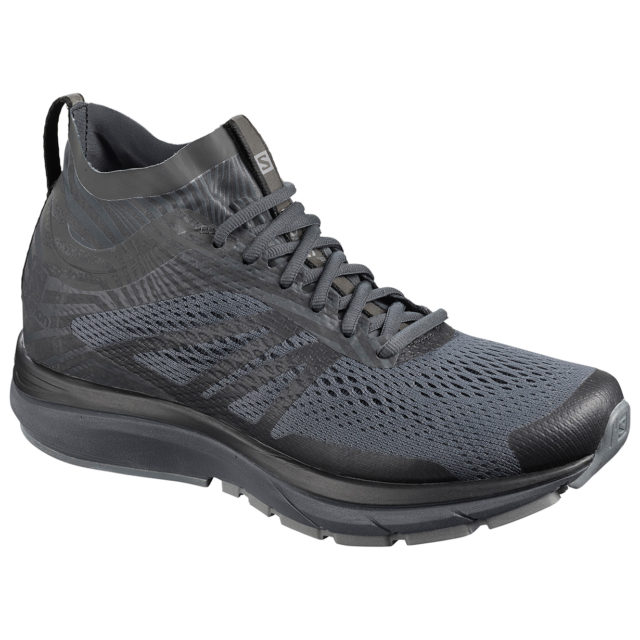
This “winterized” version of the Sonic RA 2 takes the midsole and outsole of the standard version and adds a higher cuff with a pseudo-gaiter, a minimal lightweight wool liner, and a 360° reflective print. These shoes will feel the same as the Sonic RA since they share the same midsole, but are better suited for winter and nighttime running. That said, it’s important to note that this is not a waterproof shoe.
Stack Height
- Heel: 28 mm
- Toe: 20 mm
Drop: 8 mm
Stated Weight
- Men's: 269 g
- Women's: 223 g
MSRP: $160.00
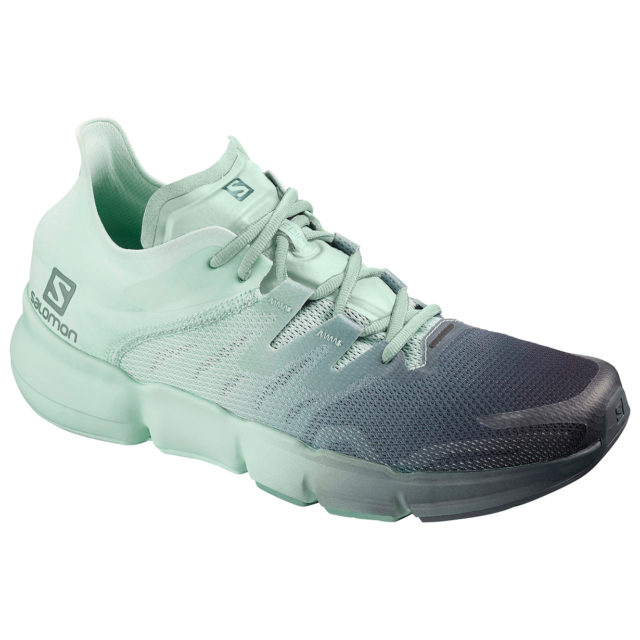
Stack Height
- Heel: 25 mm
- Toe: 17 mm
Drop: 8 mm
Stated Weight
- Men's: 260 g
- Women's: 220 g
MSRP: $160.00
Least Cushion
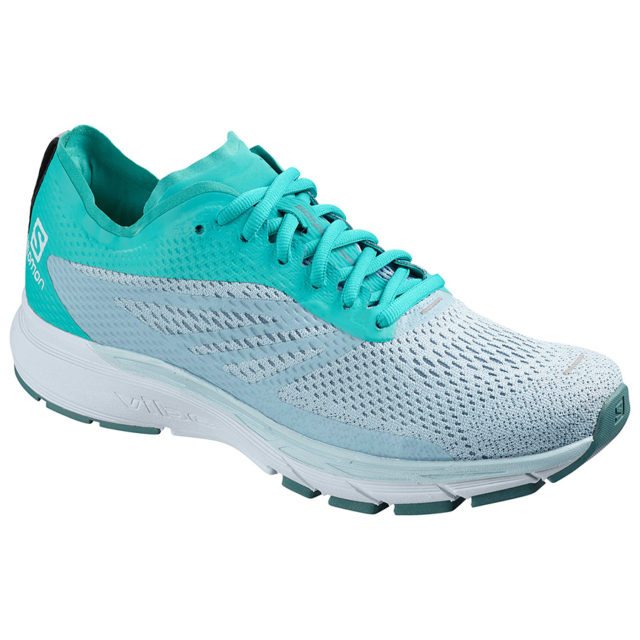
This is the lightest and most minimal model in the Salomon road running lineup. Designed to be quick and efficient, this shoe features a lower stack height and drop than the other shoes from Salomon’s road line. While Salomon’s other road shoes are designed primarily with comfort in mind, the RA Pro 2 is more targeted at people who prioritize efficiency.
Stack Height
- Heel: 24 mm
- Toe: 18 mm
Drop: 6 mm
Stated Weight
- Men's: 220 g
- Women's: 185 g
MSRP: $130.00
TRAIL SHOES
(Most Cushioned to Least Cushioned)
Most Cushion
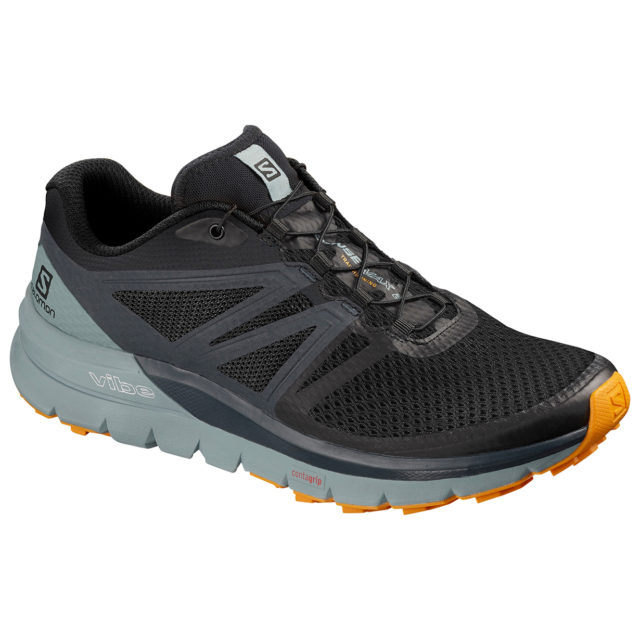
Stack Height
- Heel: 30.8 mm
- Toe: 24.8 mm
Drop: 6 mm
Stated Weight
- Men's: 285 g
- Women's: 240 g
MSRP: $150.00
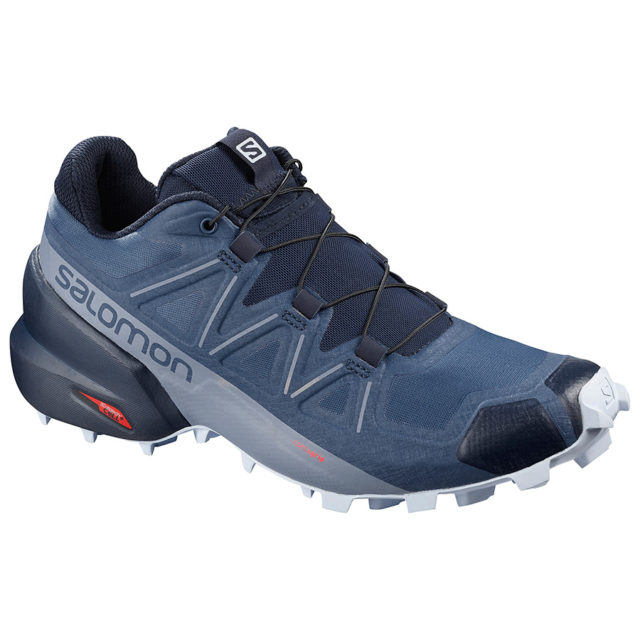
The Speedcross has been in Salomon’s line for years, and many runners love its combination of a precise, stable fit and excellent traction in wet / sloppy conditions. With really big, widely spaced lugs, a narrow fit, and more stability than the shoe above, the Speedcross 5 is designed to handle harsh terrain. The Speedcross 5 will thrive in wet conditions like snow and mud, making it a top choice for things like adventure races or just general wet trail running. Since the lugs are so big, this shoe won’t feel as efficient on smoother, packed trails compared to shoes with more minimal outsoles like the Ultra/Pro and Sense Ride 2. And if you like the sound of the Speedcross but want more weather protection or better grip in winter conditions, see the next few shoes.
Stack Height
- Heel: 30 mm
- Toe: 20 mm
Drop: 10 mm
Stated Weight
- Men's: 320 g
- Women's: 280 g
MSRP: $130.00
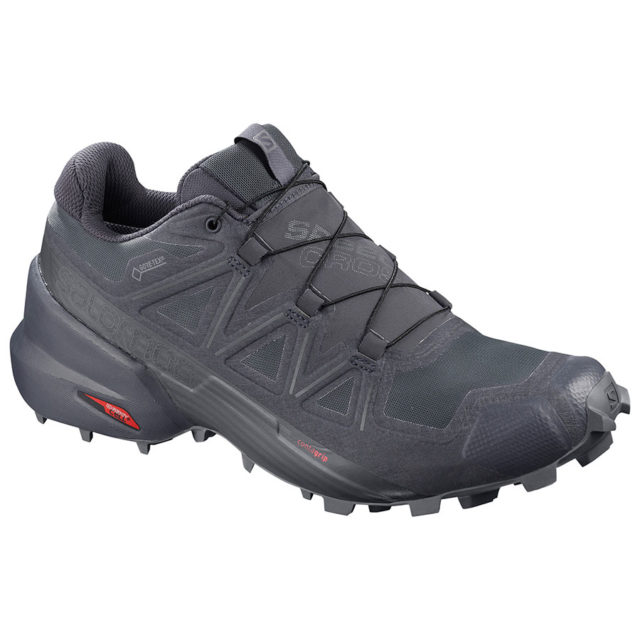
This shoe offers the same build and ride as the Speedcross 5, but adds a waterproof insert and 360° reflectivity. That makes the GTX Nocturne version better for cold and wet runs at night. If you don’t need the reflective upper, you can save some money by going with the next shoe.
Stack Height
- Heel: 30.9 mm
- Toe: 20.9 mm
Drop: 10 mm
Stated Weight
- Men's: 340 g
- Women's: 340 g
MSRP: $170.00
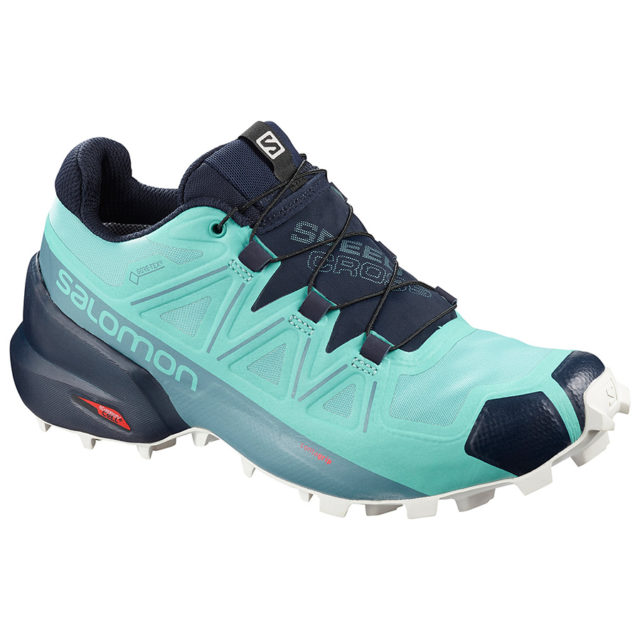
Stack Height
- Heel: 30.9 mm
- Toe: 20.9 mm
Drop: 10 mm
Stated Weight
- Men's: 340 g
- Women's: 290 g
MSRP: $160.00
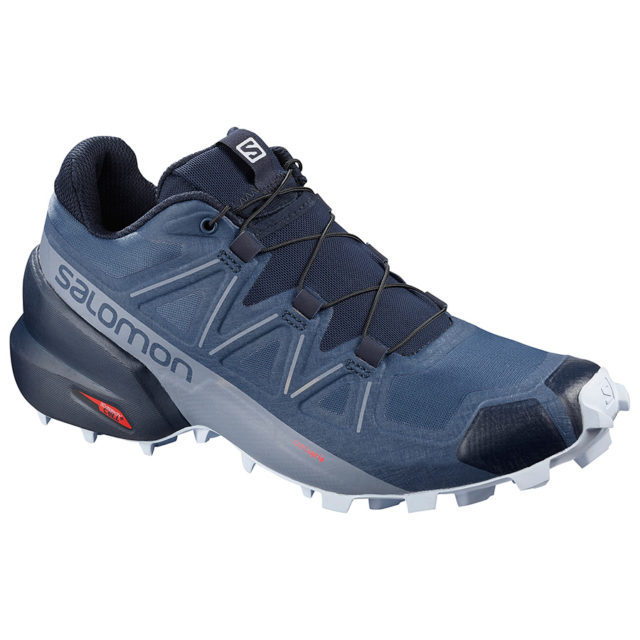
Because some individuals’ feet don’t work well with Salomon’s generally narrower fit, the brand now sells several of their best sellers in Wide versions. The Speedcross 5 Wide is one of those shoes, and Salomon claims that the circumference of the forefoot of the wide version is 12 mm larger. If the standard Speedcross 5 is too narrow for you, this is a good shoe to try. That said, we still wouldn’t call this a particularly wide or high-volume shoe, compared to the whole market. So, as always, we highly recommend trying on shoes at your local shop before buying.
Stack Height
- Heel: 30 mm
- Toe: 20 mm
Drop: 10 mm
Stated Weight
- Men's: 320 g
- Women's: 280 g
MSRP: $130.00
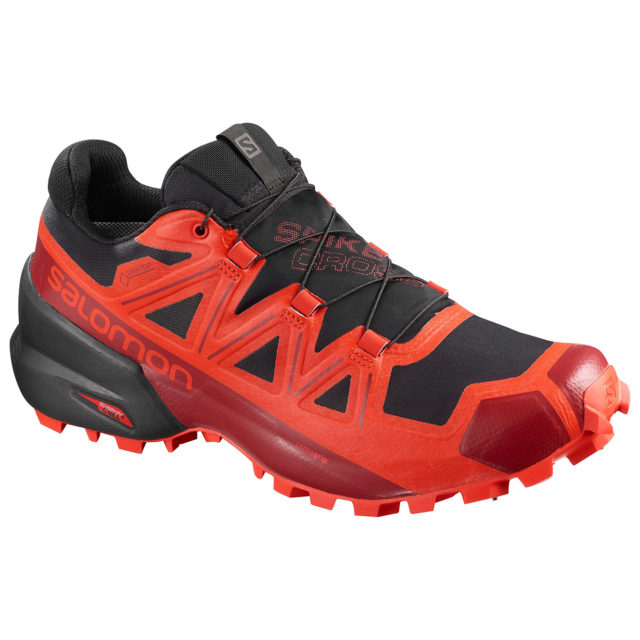
This is essentially a “winterized” version of the Speedcross 5. It takes the fit and midsole of the Speedcross 5 but adds a Gore-Tex bootie and features a “winter” Contagrip sole with 12 carbide spikes to help prevent slipping on snowy or icy conditions. For even more weather protection with the same excellent grip in winter conditions, see the next shoe.
Stack Height
- Heel: 30.9 mm
- Toe: 20.9 mm
Drop: 10 mm
Stated Weight
- Men's: 365 g
- Women's: 365 g
MSRP: $185.00
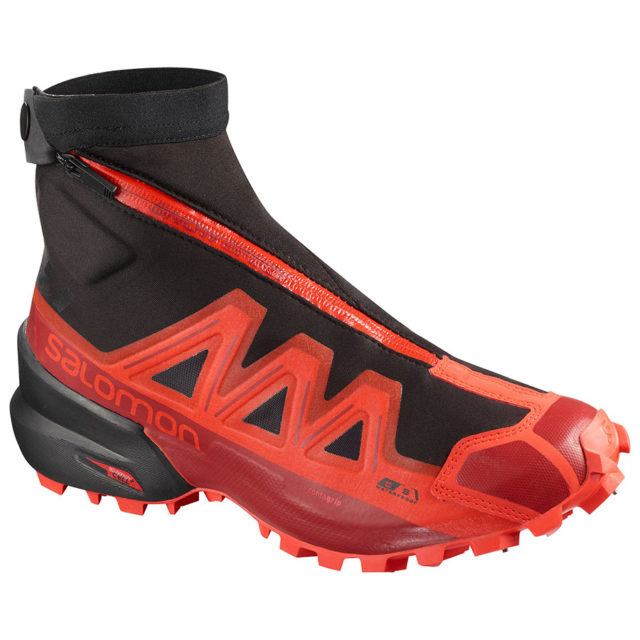
With the SnowSpike CSWP, Salomon took the SpikeCross 5 and added even more weather protection via a waterproof bootie / gaiter that extends above the ankle. This new shoe is designed to keep your feet dry, even in deep snow. With a high top and zippered gaiter to keep snow and moisture out, 12 carbide spikes in the outsole, and complete waterproof protection, this shoe is worth checking out if you need a new snow-running shoe and you get along well with the ride of the Speedcross series.
Stack Height
- Heel: 30.3 mm
- Toe: 20.3 mm
Drop: 10 mm
Stated Weight
- Men's: 400 g
- Women's: 400 g
MSRP: $215.00
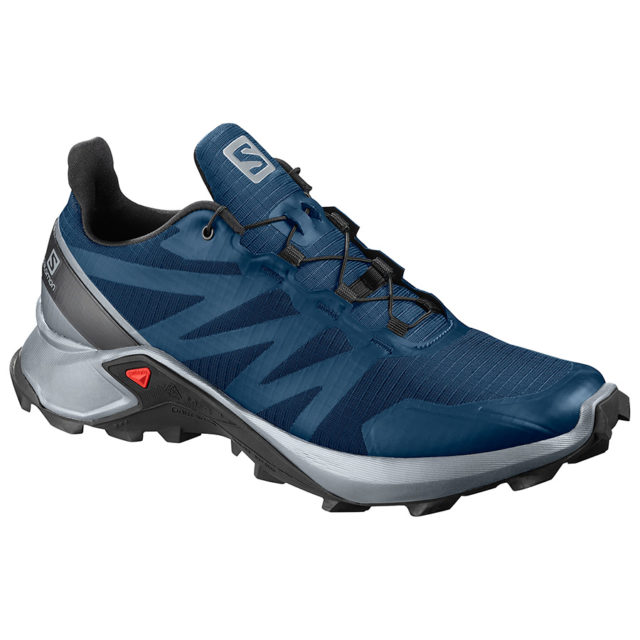
Stack Height
- Heel: 29.3 mm
- Toe: 19.3 mm
Drop: 10 mm
Stated Weight
- Men's: 310 g
- Women's: 270 g
MSRP: $110.00
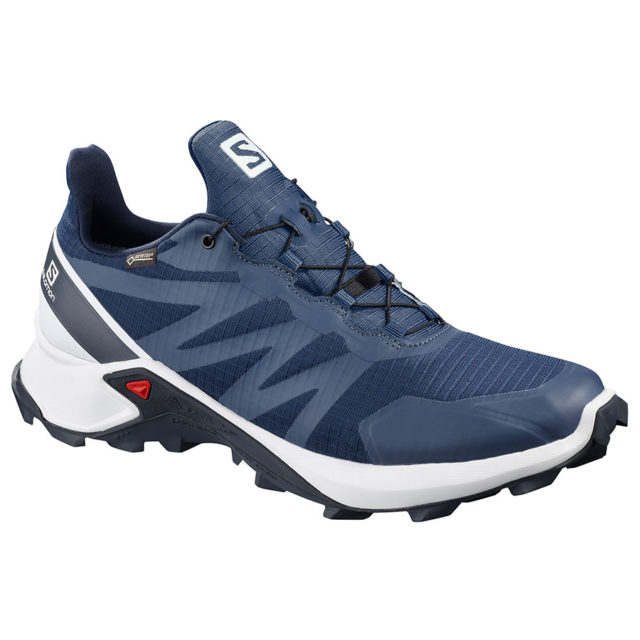
This is the same shoe as the Supercross, but with a Gore-Tex insert to keep out water, at the cost of breathability.
Stack Height
- Heel: 29.9 mm
- Toe: 19.9 mm
Drop: 10 mm
Stated Weight
- Men's: 340 g
- Women's: 290 g
MSRP: $130.00
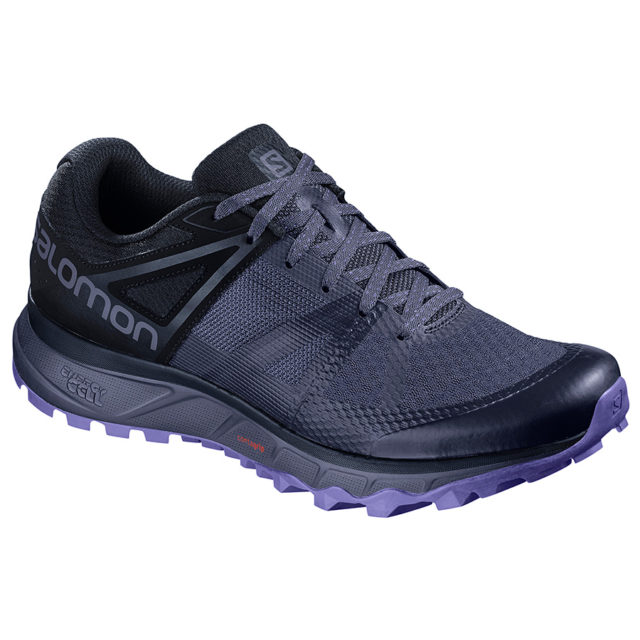
This is an affordable shoe designed for people who are transitioning from road running to trail running, and who need a shoe for both. The Trailster uses a regular lacing system and fits very similarly to many of Salomon’s road shoes. But the Trailster features a full-rubber outsole with moderate lugs to provide good grip on rocks and mellow trails, while still being efficient on pavement. It’s not the best option for really wet conditions or where maximum grip is a priority (it uses the more durable, less grippy ContaGrip rubber), but the Trailster is a solid option for a mix of road and trail running.
Stack Height
- Heel: 29 mm
- Toe: 19 mm
Drop: 10 mm
Stated Weight
- Men's: 310 g
- Women's: 260 g
MSRP: $100.00
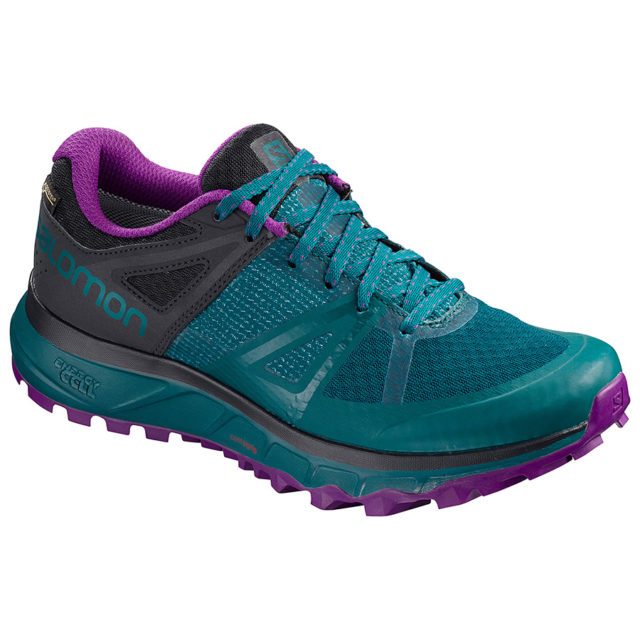
Stack Height
- Heel: 29.5 mm
- Toe: 19.5 mm
Drop: 10 mm
Stated Weight
- Men's: 335 g
- Women's: 280 g
MSRP: $120.00
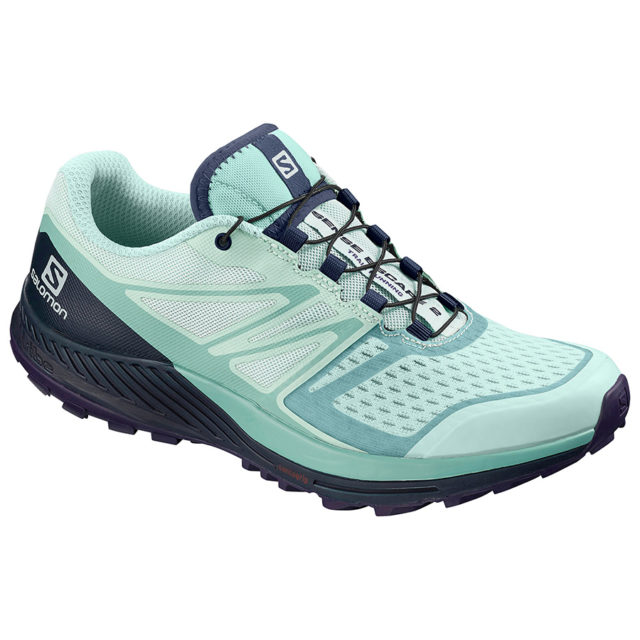
Taking the same midsole material used in Salomon’s road shoes and pairing it with a full-rubber Contagrip outsole, this trail shoe will feel similar to Salomon’s road runners, yet is designed to provide grip on a wide variety of terrain. It’s a good alternative to the Sense Ride 2 if you want something with a slightly higher drop and more cushioning in the heel, or if you’re looking for a durable shoe to transition from pavement to dirt (the Sense Escape 2 uses a more durable, but less grippy version of their ContaGrip rubber).
Stack Height
- Heel: 29 mm
- Toe: 19 mm
Drop: 10 mm
Stated Weight
- Men's: 260 g
- Women's: 225 g
MSRP: $110.00
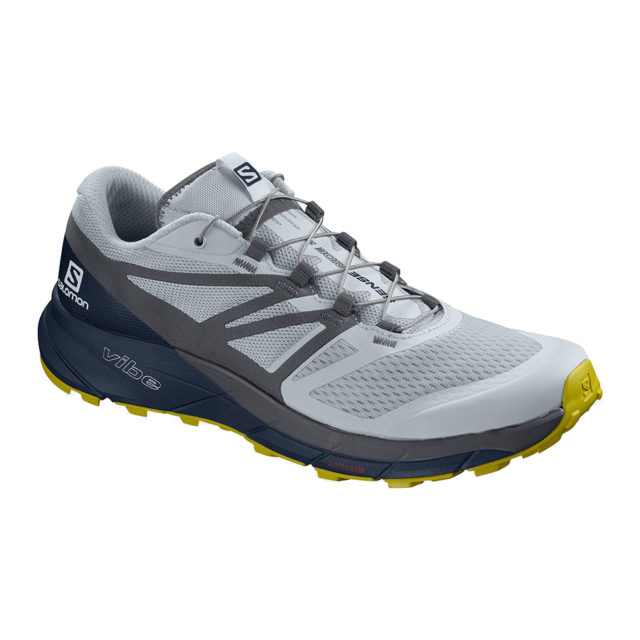
Stack Height
- Heel: 27 mm
- Toe: 19 mm
Drop: 8 mm
Stated Weight
- Men's: 270 g
- Women's: 240 g
MSRP: $120.00
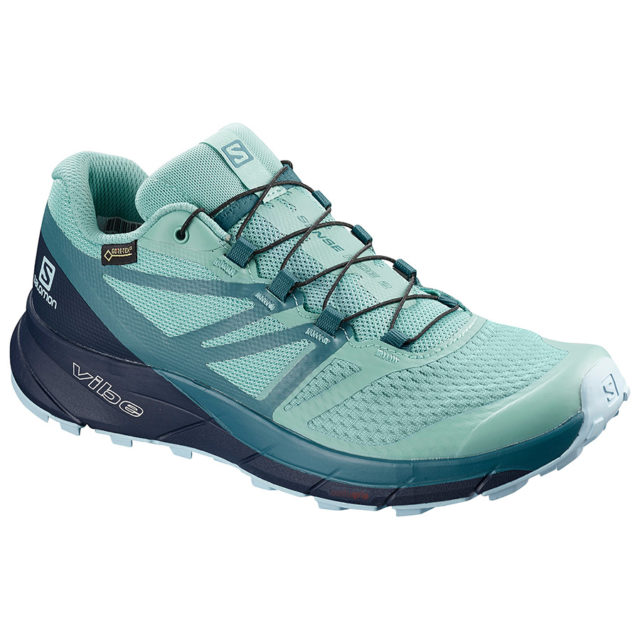
Stack Height
- Heel: 27 mm
- Toe: 19 mm
Drop: 8 mm
Stated Weight
- Men's: 300 g
- Women's: 250 g
MSRP: $160.00
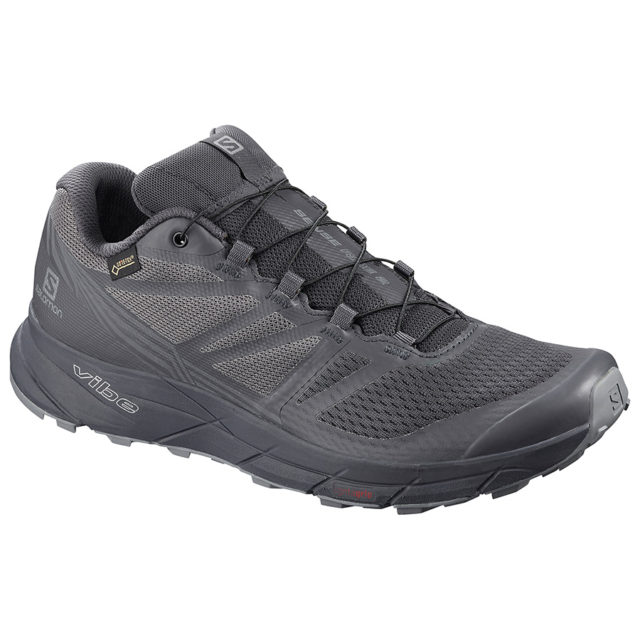
Stack Height
- Heel: 27 mm
- Toe: 19 mm
Drop: 8 mm
Stated Weight
- Men's: 290 g
- Women's: 290 g
MSRP: $170.00
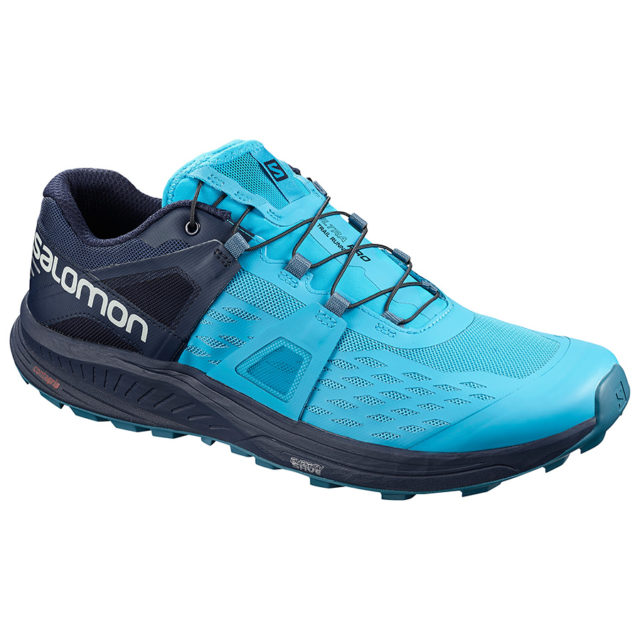
Stack Height
- Heel: 27 mm (men); 23 mm (women)
- Toe: 19 mm (men); 15 mm (women)
Drop: 8 mm
Stated Weight
- Men's: 300 g
- Women's: 260 g
MSRP: $150.00
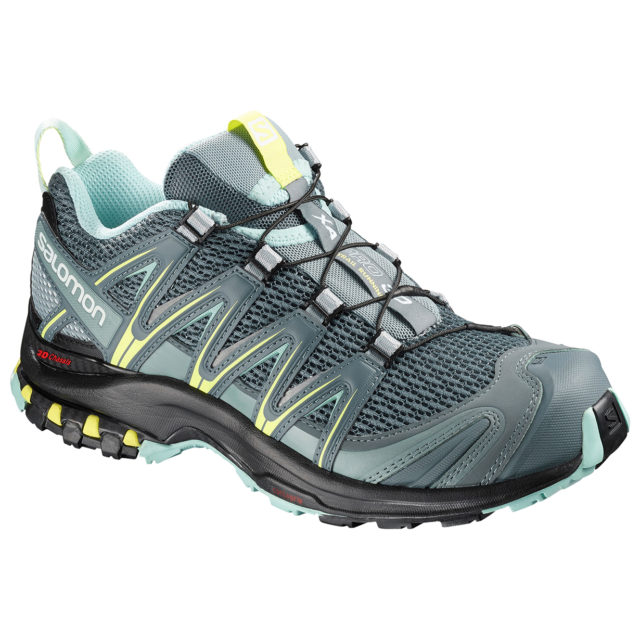
Stack Height
- Heel: 27 mm
- Toe: 16 mm
Drop: 11 mm
Stated Weight
- Men's: 380 g
- Women's: 330 g
MSRP: $130.00
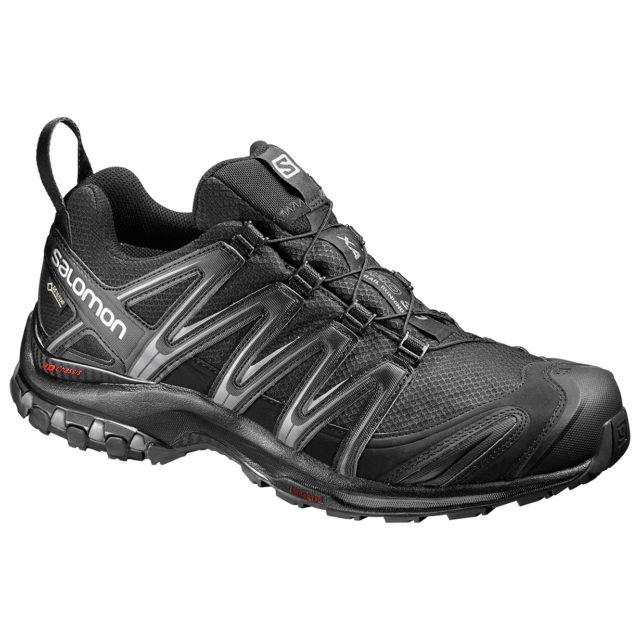
Stack Height
- Heel: 27.5 mm
- Toe: 16.5 mm
Drop: 11 mm
Stated Weight
- Men's: 390 g
- Women's: 345 g
MSRP: $145.00
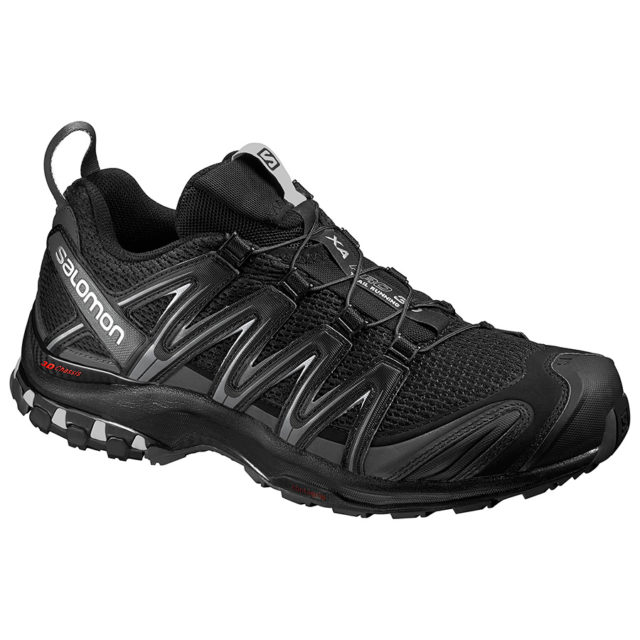
Stack Height
- Heel: 27 mm
- Toe: 16 mm
Drop: 11 mm
Stated Weight
- Men's: 380 g
- Women's: 380 g
MSRP: $130.00
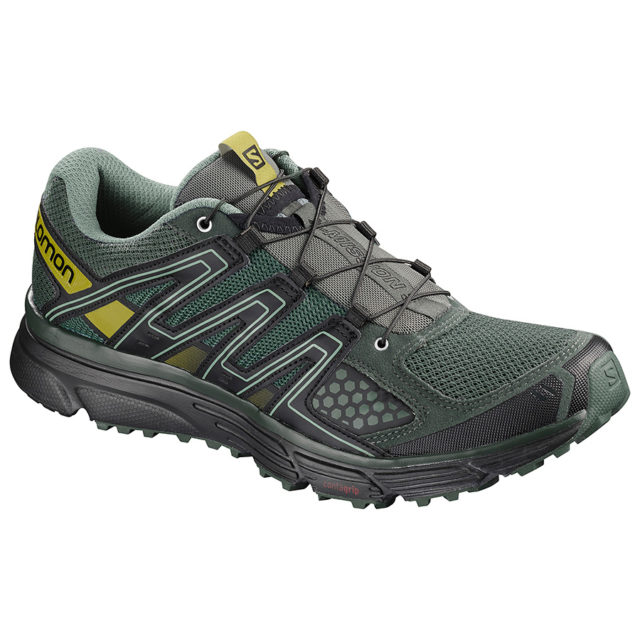
Stack Height
- Heel: 26.5 mm
- Toe: 16.5 mm
Drop: 10 mm
Stated Weight
- Men's: 300 g
- Women's: 250 g
MSRP: $115.00
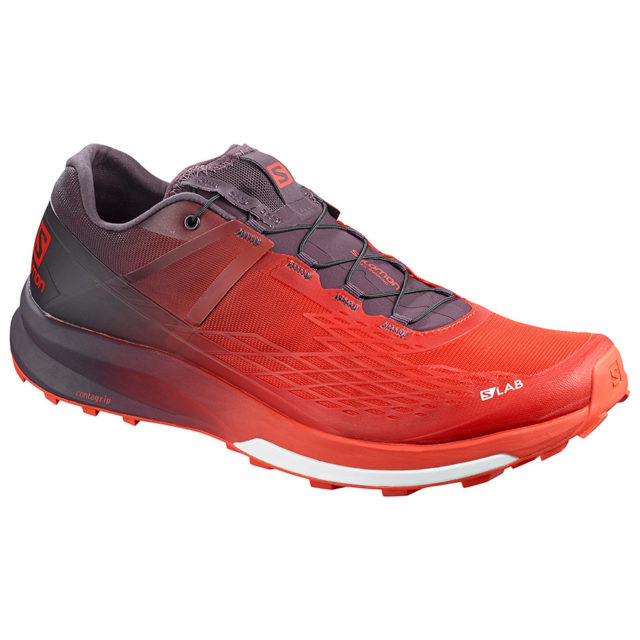
The S/Lab Ultra 2 is Salomon’s most cushioned race-oriented trail shoe. The second version of this shoe is designed to be both more durable and lighter than the original model, while still featuring the precise fit and long-distance comfort and ride that Francois D’haene (an accomplished ultra runner from France) helped to create. These shoes are very similar to the Ultra Pro but are a bit lighter, have a bit less structure to their upper, feature a higher-rebound midsole material, and likely aren’t as durable.
Stack Height
- Heel: 26 mm
- Toe: 18 mm
Drop: 8 mm
Stated Weight
- Men's: 285 g
- Women's: 285 g
MSRP: $180.00
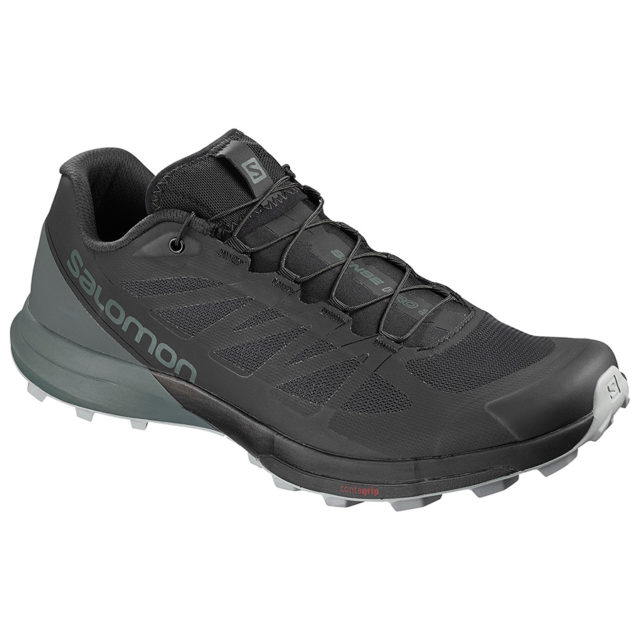
With a rockplace from the toes to the midfoot and a midsole material with more rebound / energy than the X-Mission 3, the Sense Pro 3 offers an energetic ride while doing a better job of protecting your forefoot from rocks, roots, etc. compared to the X-Mission 3 and Trailster. It has a pretty moderate lug pattern and a middle-of-the-road rubber compound which should make for a pretty durable shoe that could work well for a variety of trails and some pavement. And thanks to its very thin upper material, the Sense Pro 3 is very light. All of this makes the Sense Pro 3 an appealing option for those who like the low weight of the S/Lab shoes, but want something more durable and less expensive.
Stack Height
- Heel: 25 mm
- Toe: 17 mm
Drop: 8 mm
Stated Weight
- Men's: 225 g
- Women's: 225 g
MSRP: $130.00
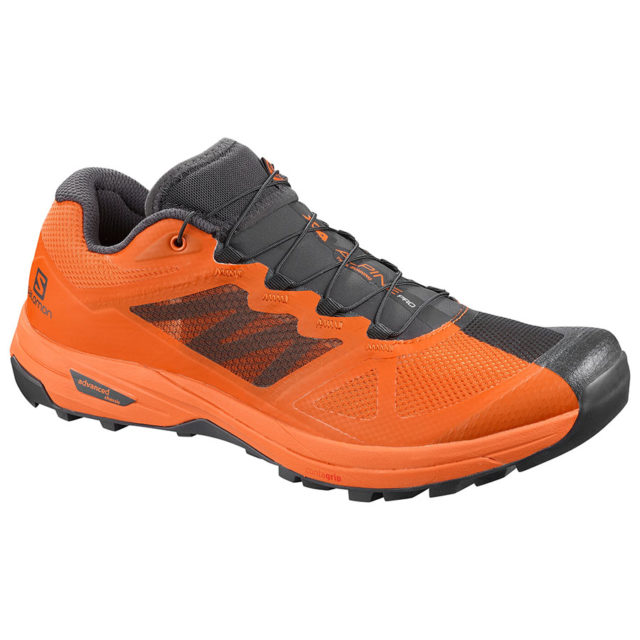
If you prefer adventures above treeline, this new shoe in Salomon’s 19/20 lineup may be a good match. As part of Salomon’s “Alpine” line, the X Alpine Pro blends features of running shoes with those of climbing approach shoes. Its outsole is designed to excel on rock, and features a flat “climbing zone” near the toe for maximum grip when scrambling. Its thin upper should be very breathable, but added overlays offer more protection than many of Salomon’s general trail running shoes like the Sense Pro 3. Lastly, the X Alpine Pro uses a more supportive chassis that’s designed to make the shoe feel stable when running / scrambling on inconsistent, rocky terrain, but don’t expect this shoe to be super forgiving / soft.
Stack Height
- Heel: 24.3 mm
- Toe: 18.3 mm
Drop: 6 mm
Stated Weight
- Men's: 310 g
- Women's: 270 g
MSRP: $160.00
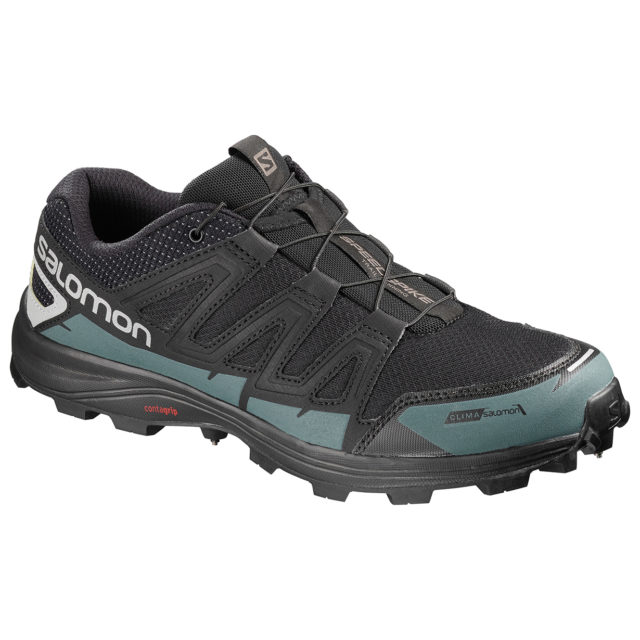
Stack Height
- Heel: 24 mm
- Toe: 18 mm
Drop: 6 mm
Stated Weight
- Men's: 305 g
- Women's: 305 g
MSRP: $180.00
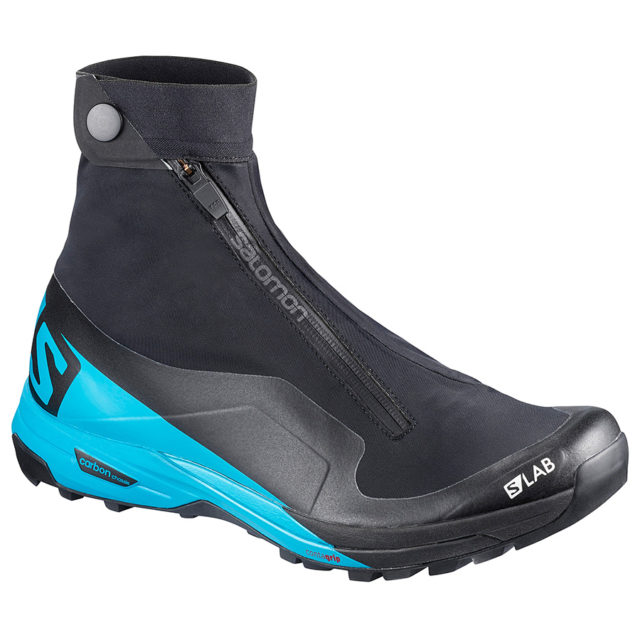
This is a pretty niche shoe designed to keep your feet dry, stable, and rock-free during runs in very technical terrain. This shoe was designed with Killian Jornet in mind, and it’s well suited for his extreme adventures. The XA Alpine 2 uses a shank and carbon chassis that make it significantly stiffer and less pliable compared to most trail shoes. The upside to this is excellent control and stability while scrambling and edging on rock. While the XA Alpine 2 does feature a full gaiter that wraps above the ankle, it’s not waterproof and is instead designed to keep rocks out of the shoe, provide a bit more protection around the ankle, and keep you dry during the ocassional glacier / snow crossing. If you don’t tend to run in a lot of extremely rocky terrain, the other trail shoes here will be better (and far cheaper) options. But if you want to run fast on the most technical alpine terrain, the XA Alpine 2 is worth a look.
Stack Height
- Heel: 22 mm
- Toe: 16 mm
Drop: 6 mm
Stated Weight
- Men's: 370 g
- Women's: 370 g
MSRP: $250.00
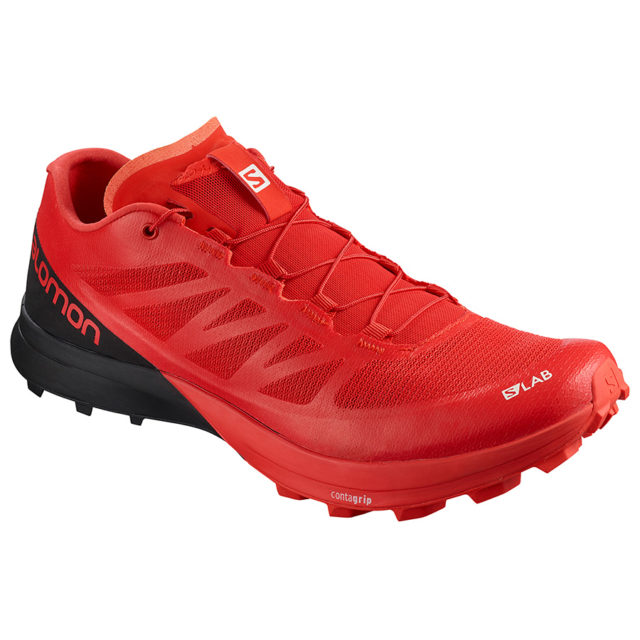
Stack Height
- Heel: 22 mm
- Toe: 18 mm
Drop: 4 mm
Stated Weight
- Men's: 205 g
- Women's: 205 g
MSRP: $180.00
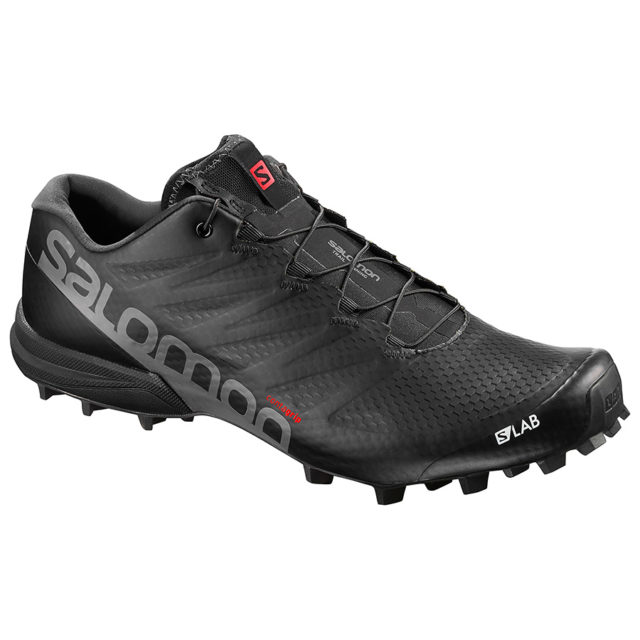
The Speed 2 is designed for racing in wet, slippery, and muddy conditions. The S/Lab Speed 2 is very similar to the Speedcross 5 in shape and fit, but with a lighter and thinner midsole designed for efficiency and speed. If you are going to be racing on muddy or slick terrain, this may be a good shoe to check out.
Stack Height
- Heel: 20 mm
- Toe: 16 mm
Drop: 4 mm
Stated Weight
- Men's: 265 g
- Women's: 265 g
MSRP: $180.00
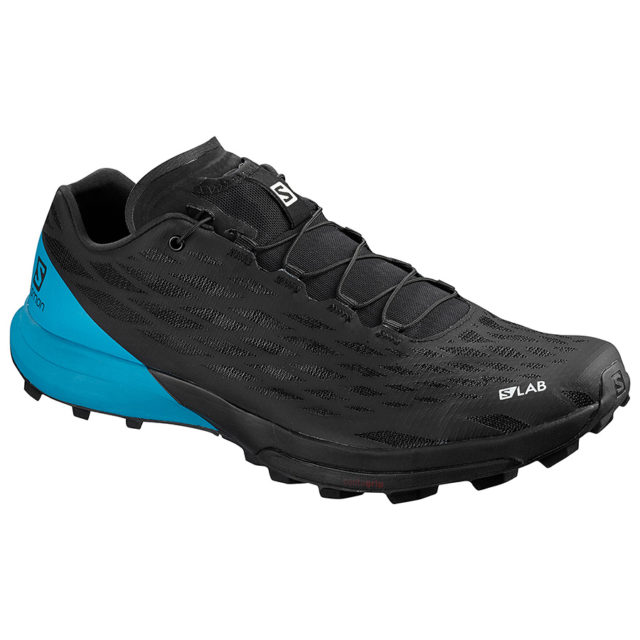
This is another fairly niche shoe, designed specifically for runs that involve a lot of water, whether that be river crossings, rain, or races that include both running and swimming. Rather than using a waterproof insert to keep water out, the S/Lab XA Amphib 2 uses a very breathable open-knit upper designed to let water move in and out of the shoe and dry quickly. It also features a ContaGrip outsole with a rubber compound specifically designed for wet terrain, though the lugs don’t seem as ideal for really sloppy, deep conditions (e.g., mud & snow) compared to the S/Lab Speed 2. The S/Lab XA Amphib 2 is also very light with an energetic midsole, protective film insert, and fairly minimal cushioning.
Stack Height
- Heel: 20 mm
- Toe: 16 mm
Drop: 4 mm
Stated Weight
- Men's: 215 g
- Women's: 215 g
MSRP: $180.00
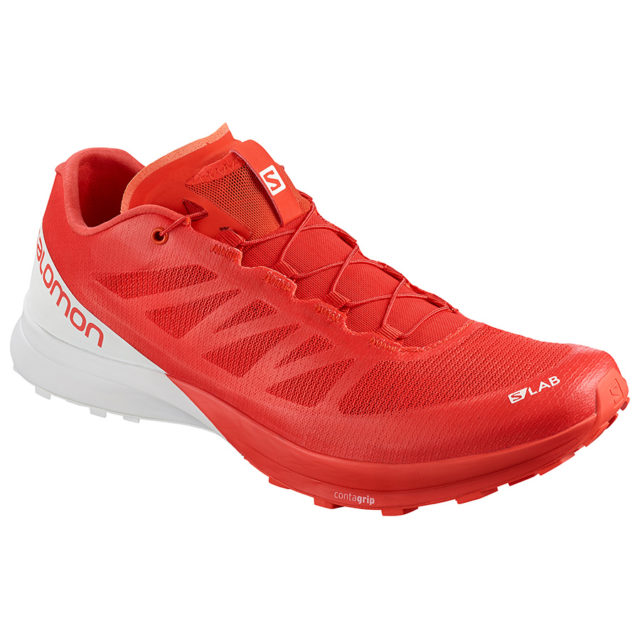
This is Salomon’s lightest and most minimal trail shoe. The Sense 7 has a rock plate that goes from midfoot to the toes; it is just enough to protect the soft spots of the foot from sharp rocks without adding bulk. The shoe is extremely light with very minimal cushioning, making it ideal for racing but probably too minimal to be an everyday shoe for many people. The lugs on the Sense 7 are smaller than the Sense 7 SG, making them ideal for smooth, rocky, rooty terrain without much mud or moisture. If you are in the market for a new trail-racing shoe and you prioritize low weight and ground feel, the Sense 7 is worth a look.
Stack Height
- Heel: 19.5 mm
- Toe: 15.5 mm
Drop: 4 mm
Stated Weight
- Men's: 195 g
- Women's: 195 g

Thanks for the rundown. I used to be a loyal Salomon customer, but veered away as I found myself wanting more specialized shoes. I had two pairs of the Sense Max (I believe just the 1s). They were awesome shoes for a mix of light trail and asphalt. Super super comfy/soft shoes that don’t feel too energy taxing. If you find yourself hopping around on rocks or uneven terrain the soles of your feet are going to hate you though. I decided to try out the Altra Lone Peaks this summer as they offer a lightweight rock plate. Somewhat comparable, but again I found myself pushing the limits of the Lone Peaks. I used them for some alpine ascents and my feet got their ass kicked. My toes were bruised up from lack of a solid bumper and I tore up the soles pretty quickly in high Sierra terrain. I don’t really have a point except for yes… you kind of do need a few pairs of runners/trail runners to not screw up your feet. Wearing shoes for purposes beyond their intended use is not a recipe for success :).
I am most intrigued by the X Alpine Pro. After screwing up my feet on the Tahoe Rim Trail last summer (Sense Max) and screwing them up even more in the High Sierras (Lone Peaks), I think it is time to beef things up a bit. 310g is not bad at all and the Salomon fit + pull string laces are extremely appealing! I’m also loving that 6mm drop. As an everyday low drop person I have found that 6mm is about the highest I can tolerate before my shins start yelling at me. Looking forward to more guides likes these for companies like Altra, Hoka One One, and maybe La Sportiva!
Thanks for the feedback! And we have actually already posted our guides for both Hoka and Altra, and have a La Sportiva guide coming up in the near future. You can see all of the running shoe Brand Guides here: https://blisterreview.com/category/gear-reviews/running-shoes/blister-brand-guides-running-shoe-lineups
This is SO useful! I’ve been a Salomon user for the best part of 15 years and I find their current line-up to be a little confusing. This clarifies things.
BTW, have you had much feedback about the durability of the Sense Ride 2? I wore through the fabric/mesh upper pretty quickly where my forefoot bends and in fact Salomon here in South Africa have just refunded me in full. That’s why I needed a clear view of the range, though I’m not 100 percent certain I’ll be staying with the brand.
Thanks for the feedback, Adrian! I have ran in the Sense Ride 2’s a decent amount and am a pretty big fan of the shoe. I have had issues with wearing through the upper in the same spot that you are describing. I find that all of Salomon’s uppers tend to wear relatively quickly, which is unfortunate. I think you can expect a pretty similar wear as the original Sense Rides on the new model.
Hi Maddie, just went and bought a pair of Sense Pro 3…they feel so amazingly light after running in a pair of tired old XA Lites for a while. Next up is a pair of S/LAB Sense 7 which I’ll save exclusively for racing.
This is the most useful shoe review I’ve ever read. Thanks.
Thanks Maddie for the excellent write-up this has been helpful in the process of acquiring a shoe that is capable of road/trail running and is not screaming performance the whole day. You know the ideal holiday 1 shoe quiver.
I eventually settled for the Trailster 2. I already own a couple of Salomon trail running shoes (Ultra Pro, S/Lab Ultra and the S/Lab Speed) so I’d figure sizing would be easy. The Trailster fit is on the small side though, next time I’d pick it one size bigger. Another thing I noticed, especially with a 40lbs child carrier, is that they are not that supportive. The fabric upper of the shoe is not holding my feet back properly and I have a feeling that I have to claw my toes in the sole to hold a decent grip. This is illustrative, it may sound a bit more extreme than it really was. In contrast I haven’t had any problems with carrying big loads with the Ultra Pro 2. I guess that the wings on the sides offer more support.
Of course I’m fully aware that I’m venturing way past the intended use of the shoe, running and trailrunning. But I thought it might be useful to other readers to look out for. I’m coming from a background where “you have to wear at least a category B hiking boot on the trail” and ventured into under-shoeing. I think I’ve reached a certain point where performance is dropping vastly.